In a world without oceans, the spires of mighty Mu and Atlantis tower above the abyssal plains—until an icy doom plunges from the sky, and floodwaters deluge the deeps of the Earth.

No, this is not a trailer for a hackneyed sci-fi movie. It is a self-styled “scientific” proposal that aims to up-end current models in geology, oceanography, evolutionary biology, paleoanthropology, and archaeology, and replace them with…the Truth. It is the brainchild of Michael Jaye, a retired army vet who taught mathematical applications at West Point and later at the Naval Postgraduate School in Monterey, CA, with a PhD from Rennsselaer Polytechnic Institute. He is also a man with a mission: to correct the grievous error Geology fell into nearly two hundred years ago.
That error, according to Jaye, began with Adam Sedgwick’s 1831 (partial) recantation of his belief in a worldwide Noachian flood. Since then, it seems, geologists have been indoctrinated into a “no flood, ever” mentality, where they deny, misinterpret, or suppress geological evidence to hide the fact that a global flood indeed took place—only it flooded the empty ocean basins, and not the land. The geologists are, he says, practicing anti-science. In particular, he is dismissive of plate tectonics (there could not possibly be currents or plumes of magma moving under the crust and slowly pushing the plates around) and turbidity currents (formations like the Monterey Canyon must be remnants of subaerial river systems from before the Deluge.) The fact that both those processes are ongoing, observable, and well-supported by multiple lines of evidence does not faze him.
Here is Jaye’s version: throughout most of its existence, up to about 12,800 years ago, Earth owned only a fraction of its current supply of water, scattered around the globe in insignificant puddles. Sixty-five million years ago, two monstrous impactors (neither of which was the Chicxulub object) struck Earth simultaneously near Australia, tilted the axis to its present angle, and sent the continents skittering about like leaves in a high wind into their current positions, all in the space of about twenty minutes. The continents have not moved since.
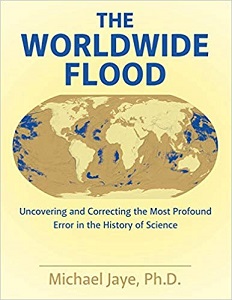
Fast forward to 12,800 years ago. Humankind had meantime evolved, not in Africa, but in the lowlands between the continents, soon to become the ocean floor. White people evolved in the deeps, and brown people on the upper slopes, because of the relative strength of UV radiation at those elevations. (Jaye does not think much of the hominine fossil record.) Atlantis grew into a mighty civilization in what would become the Atlantic, while Mu flourished in the future Indian Ocean. Apparently, Gobekli Tepe had been founded as well, so there must have been some people living on the continents. Then came the Day of the Comet.
And no piddling little ordinary comet, either. Jaye’s comet was a 2500-km-wide monster-ball of porous ice, loosely packed around a dense metallic core about 100 km in diameter, with a mass of about 2.88×1015 tonnes. That’s just the core. Jaye estimated the mass of the water frozen into the outer layer at a whopping 1.29×1018 tonnes, enough to fill all those empty lowlands and abysses with meltwater to an average depth of 3.57 km. And that, O Best Beloved, is how the Earth got its oceans. Less than thirteen thousand years ago.
Mind you, it was not a gentle process. Atlantis and Mu were overwhelmed by the floodwaters, along with all but a few thousand humans. (The people of Gobekli Tepe somehow survived, to record the event.) The Americas were pockmarked with small impact craters where chunks of ice had fallen off the Impact Object (IO) as it fragmented in the atmosphere. The sudden influx of all that meltwater disrupted ecosystems, drove the megafauna to extinction, destroyed forests, and brought about the Younger Dryas cold snap. Yes indeed, this is a version of the Younger Dryas Impact Hypothesis, though I somehow doubt other YDIH proponents will thank Jaye for his contribution. This is because it is a breathtakingly stupid idea.
The evidence that Jaye claims should trump two centuries of geological research is mainly a kind of Google Earth pareidolia. There is a crescent-shape on the border of the Indian and Southern Oceans, between Madagascar and Antarctica, which represents the IO’s massive crater. Little circular or oval formations all down the Americas, particularly in Patagonia, represent the impact of ice fragments in the comet’s wake. A gigantic grid pattern on the Atlantic sea floor northwest of the Canaries represents the wrack of the Plain of Atlantis, devastated in the Deluge.
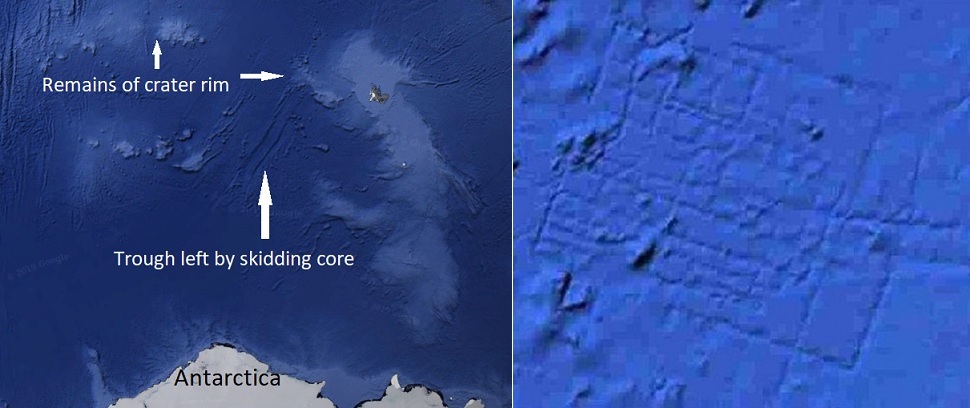
Here is Jaye’s scenario: the massive IO started breaking apart as it hit the atmosphere, shedding chunks of ice all the way, and thudded to a halt in the arms of its new crater. The dense metallic core skidded along the seabed for 1000 km, leaving an enormous trough behind it. The size of the crescent reveals the diameter of the IO; the break between the crescent’s two arms indicates that the IO, being porous and fragile, was splitting as it fell. Then all the ice melted, absorbing enough energy to bring about the Younger Dryas cooling event even as it filled the ocean basins from the bottom up.
There are problems.
First, the dry, dry antediluvial Earth. Jaye claims his comet delivered 1.29×109 km3 of water. Earth’s total water at the moment (not counting the vast amounts tied up in the core) is about 1.386×109 km3. This means that Earth had to struggle along for four and a half billion years on 9.6×107 km3, or about 7% of our current holdings, out of which we had to budget for glaciers, ice ages, all those ancient sedimentary seabeds, biogenesis and evolution, the extensive forests and great river systems Jaye mentions, and eventually the needs of advanced pre-Deluge civilizations with huge irrigation systems. He hand-waves away the overwhelming evidence for oceans going back at least four billion years, because all geologists continue to be brainwashed by the ghost of Adam Sedgwick. But—what about the hydrologic cycle? What about salinity? Marine fossils? The sedimentary deposits of ancient seas? Whales? Penguins? And so much more. No, this part of Jaye’s thesis is such folly that one could really stop right there. But I won’t, because I’m something of a masochist.
Consider the morphology of Jaye’s IO. He informs us confidently that it consisted of a dense metallic core about 100 km in diameter, surrounded by a porous shell of ice about 2500 km across. A comet with a metallic core? A comet that was orders of magnitude larger than anything ever known to come out of the Oort Cloud? This strains credulity even before the IO reaches Earth. But even worse is that Jaye blithely skips over the effects of such a huge mass hitting the Earth at cometary speed. He seems to assume that, since most of the mass was ice/water, and it would break up in the atmosphere, the blow would be cushioned. With a diameter of 2500 km, however, most of it would still be high in the exosphere, still frozen, at the time the leading edge touched down.
Looking at the two components of the IO separately, Jaye’s figure for the mass of the ice shell works out to 1.29×1018 tonnes. The estimated effect, using Impact:Earth! and figures derived from Jaye’s paper and book, is shown in Fig.1: 1.4×1029 megatons of TNT, a seismic wallop of 14.1 on the Richter scale, and a melt pool larger than the final crater (a phenomenon which has never actually been preserved, since an impact of this magnitude has not taken place since the Late Heavy Bombardment in Earth’s infancy). The ice would not collect in the basin and proceed to melt in a civilized fashion; it would vaporize, along with a hefty chunk of crust.
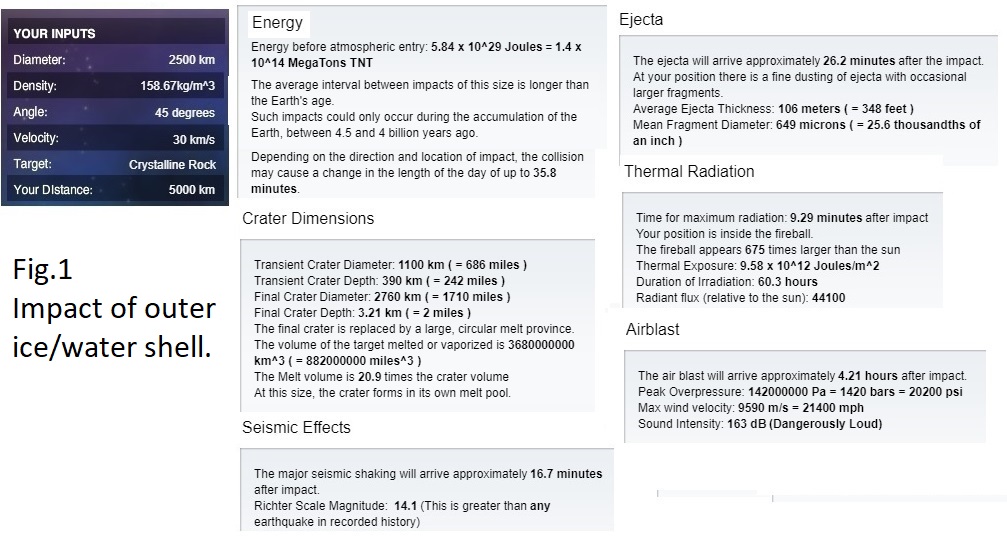
But forget about the ice for the moment; the metallic core would make a pretty grand entrance of its own (Fig.2). Using Jaye’s claim of 100 km in diameter and a mass of 2.88 x 1018 kg, this puppy would outmatch the Chicxulub impactor by up to an order of magnitude, and we all know how well the Chicxulub impact turned out. It would also be difficult for the core to leave that tidy 1000-km skidmark along the seafloor, since it too would have vaporized on impact.
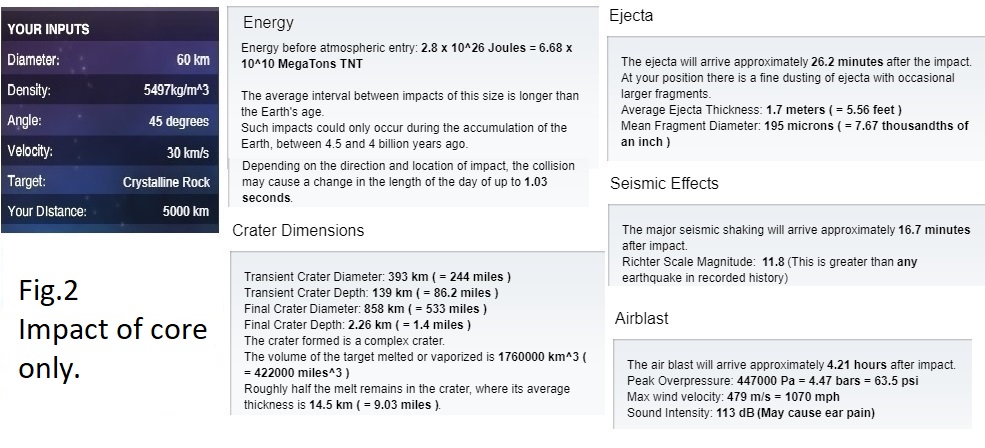
Jaye appears to have derived much of his concept from “new evidence”—that is, the fruits of much diligent poring over Google Earth looking for things that look like things. He even compares Google Earth to Galileo’s telescope:
As the telescope led to the end of geocentrism, so the new data (e.g. Google Earth) [will] nullify geology’s prevailing paradigm that has us all believing that there was never a worldwide flood.
Alas, Jaye made some unfortunate choices of things that look like things. His 12,800-year-old crater, for example: the segment on the west is the Crozet Islands, a small volcanic archipelago that began to form over a local hotspot about nine million years ago. The segment on the east is the Kerguelen Plateau, a microcontinent situated on another major hotspot, originating as long as 130 million years ago.
The “ice-impact craters” down the length of the Americas are a mixed bag. Fig.3 in Jaye’s article shows a nice view of some maars from the Pali Aike volcanic field in Patagonia, which has been active for nearly four million years. Some on his list that I randomly checked out are clearly playa lakes or kettle lakes, or even dugouts, while others are indeterminate from a satellite photo. Nowhere does Jaye justify his claim that they all date from 12,800 years ago.
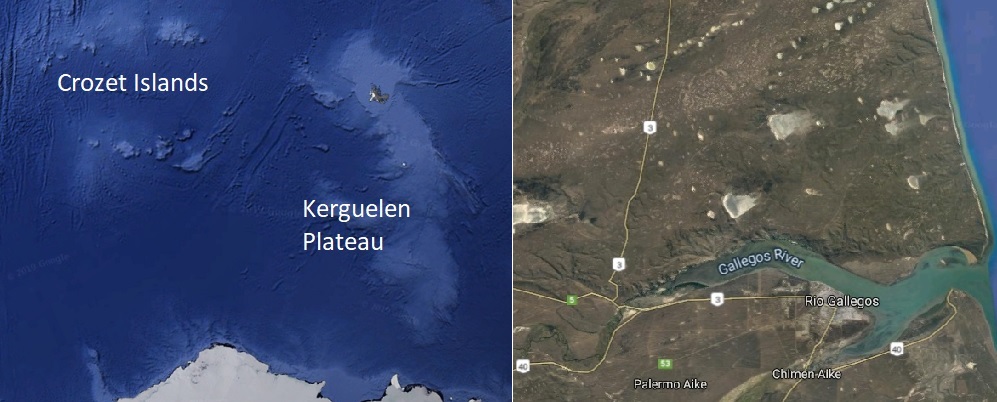
Most face-palming of all, Jaye trots out the long-debunked “grid” on the Atlantic seabed west of the Canaries, identifying it as the plains of Atlantis described by Plato. It is not an artefact of a pre-Holocene high civilization; it was an early Google-Maps artefact of combining datasets and images of differing resolutions from different sources, and has now been corrected. The grid is not there. Jaye doesn’t buy that.
Indeed, Jaye doesn’t buy any geology. He has total confidence in his startling rewrite of Earth’s history—it is the geologists who are practising pseudoscience. From his website:
The task remains: how do we get geologists to recognize their error? Should we treat them with derision? Do we mock them for adhering to an incorrect tenet as if it were religious dogma? I am not sure, but this much is certain – they must recognize their error. They must be asked: Why do you believe there was never a flood? and Do you not recognize the logical error committed by your predecessors? We must make them reform. We must carry out the task of correcting the most profound error in the history of science.
Where have we heard this kind of thing before? Well, we hear it all the time from, say, Flat Earthers and Creationists and fringe scholars, the von Danikens and Hancocks and Tsoukaloses of the world. But we’ve also been hearing it from an odd source: qualified, intelligent scientists who are apparently perfectly competent in their own field. We heard it from Danny Hilman Natawidjaja, who presented a pile of columnar andesite as a pre-Holocene pyramid, and wrote a very silly self-published book. We heard it from Martin Sweatman, who constructed an elaborate prehistoric fantasy shored up by ill-conceived statistics, and wrote a very silly self-published book. We hear it now from Michael Jaye, whose work is even loopier than the first two, and who wrote a very silly self-published book.
Sweatman, in particular, has consistently claimed the academic high ground because he published his theory in a peer-reviewed scientific journal. Funnily enough, Jaye also published his theory in a peer-reviewed scientific journal.
Even funnier, it was the same peer-reviewed scientific journal…

Note: My inimitable colleague Carl Feagans has also written an article on Jaye’s theory, with further insights: https://ahotcupofjoe.net/2019/11/the-pseudoarchaeology-of-michael-jayes-worldwide-flood/?fbclid=IwAR1H9TpuAInWjfM-2KnYPX1KIIs_Tm1B04q48msDTbf9hU1-g4qnNamuDjE
